FPV Drones have a frame that retains all of the quadcopter's parts and protects the electronics inside of them from damage. This article outlines the quadrilateral frame. We should pay attention to how to obtain the best drone frame and how the frame affects flight performance. There are many considerations in choosing the ideal framework according to your personal needs and style.
What is a quadrilateral frame?
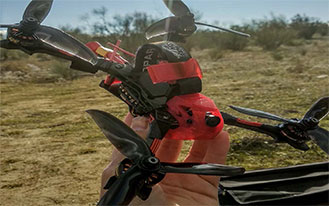
A square frame is the main structure of four-axis aircraft. The frame or chassis of a four-axle aircraft has different parts. Some frames have all four arms cut from a single carbon fiber palte, which is often referred to as a monomer or individual. Some protect the front FPV camera, which is often referred to as the camera's "protective shell". The perfect quadrilateral frame should be light and strong. But like so many things, drones need sacrifice and balance. The design and materials of the frame determine its impact resistance. Generally, the stronger frame is heavier and more stable in the air.
Lighter frameworks are more efficient and flexible. The lighter frame requires a lower throttle hover, so the flight time can be extended. It can also react faster to paste input and speed up. However, some lightweight frames may use thinner materials, which tend to bend and vibrate during flight. This will affect FC and PID controllers and make adjustments very troublesome. In addition, ultra-light frame will sacrifice the protection of components. Four-axis aircraft frame has a significant impact on your flight performance: aerodynamics, weight distribution, stiffness, etc. all play a role in flight characteristics.
Material of quadrilateral frame
The quadrilateral frame can be made of any material you may think of: wood, 3D printing plastic, injection molding plastic, glass fiber, aluminum, and even PVC pipe. However, due to its relatively low cost and excellent physical properties, carbon fiber is still the most popular quadrilateral frame material:
1. Lightweight - lighter racing drones mean faster speed, better flexibility, longer flight time.
2. less destructive inertia in collisions
3. Rigidity - CF has a high stiffness-to-weight ratio. Frame stiffness is important for stability and flight performance
4. However, there are some disadvantages of using carbon fiber in frames:
5. Carbon fiber is conductive. If your belt contacts the frame, it may cause a short circuit and burn the components
6. It also blocks RF signals (such as 2.4GHz and 5.8GHz), so please make sure your antenna is not hidden within the frame
Building quadrilateral frames
The quadrilateral frame can be simply divided into two parts: the body and the arm. The fuselage can accommodate and protect your electronic components, including flight controller, PDB, FPV camera, vtx, etc. It usually consists of a bottom plate, a top plate, and some supports, which are used to fix them together. The arm is the place where the motor is installed, which is usually also the installation of ESC. The design of these arms is durable. They are usually made of 4 mm to 5 mm carbon fiber (CF) board. Now 5.5 mm or even 6 mm CF is becoming more and more common.
Wheelbase size
The size of the wheelbase of the four-axis aircraft frame is in millimeters, and the size is the diagonal motor to motor distance. Quadrilateral frames are usually designed for specific propeller sizes, so frames can also be referenced based on propeller sizes. Therefore, when you hear people describe a "five-inch frame", it means that the size of the frame is suitable for five-inch props. The size of the mini quadrilateral frame determines the choice of most components you will use in your build. A more powerful UAV requires a larger frame for longer props and larger motors, while a smaller frame will use shorter props and smaller, lower power motors. The frame tends to be as small as possible to reduce weight and keep the motor as close to the center as possible. The motor is installed at the extreme end of the arm. The farther they are from the center, the greater the moment of inertia, which introduces the trend of resisting angular acceleration and deceleration. Under all other conditions, the smaller the frame, the more flexible the process is. In addition, the larger the frame, the greater the air resistance when flying forward. Due to the increase of materials, the weight of the frame will also increase.
No matter how many "mm" the size of the frame is, the supporting size of its support should be checked. For example, a 5 "frame may be larger or smaller than 210mm. Sometimes a 250mm frame may only accept 5-inch but not 6-inch props. It all depends on the actual design. Although you can run a smaller propeller on the frame, please always try to avoid doing so to obtain the best performance. When using the largest propeller that can swing, the quadrangular frame performs best.
Frame shape and arm layout
The shape of the frame or the layout of the arms is determined by how the arms are connected to the body. It will not only affect the appearance but also affect the flight performance on multiple levels. At present, the popular frame style is:
H
X
Mix x
Square (box)
PLUS
The motor layout may look very similar and rectangular, but each of these frame types has a different performance to some extent. Whether different arm layouts provide any real benefits has always been a controversial topic. But according to my own personal experience, they feel different in the air.
Type H
Early quadrilaterals began with an H-shaped frame. They look like infinite component space, but these frameworks are very easy to build.
The arm is connected to the "H" shaped frame at the front and rear of the main body. It creates a long and spacious body that can comfortably accommodate your electronic equipment.
The HD camera and battery can be placed on the top plate, and the weight of the quadrangle is more dispersed. For this reason, due to the large moment of inertia on the pitch axis, it may be less agile than the new x frame. However, some people prefer this behavior to achieve a smoother freestyle flight.
Type X
On the X frame, all arms meet at the center to form an "X" shape with equal width and length. Shorten the body as much as possible to achieve a more concentrated mass. Compared with the H frame, this can reduce the moment of inertia, and finally achieve faster flight characteristics, which is more suitable for FPV competition. Due to the reduction of materials, the X-frame is also lighter. However, due to its small size, your components must be stacked in the middle, which may be more challenging to build. People sometimes call it "true type X" to distinguish it from other types of type X.
Hybrid-x type
Hybrid-x has x frame arms and a long body of H frame. Some people believe that in terms of flight characteristics, this is almost no different from the H frame, mainly because the mass distribution is the same. But I think there are differences in the way the thrust is applied to the frame (considering leverage). The way in which propeller/motor vibration is transmitted to FC in different directions through the arm may also change.
Stretch x
Similar to the appearance of the "true-x" frame, "stretch X" has a further separated forearm and rear arm. Our idea is to reduce air disturbance and improve the cornering performance of racing cars and high-speed flights. Moving the rear strut away from the front strut can minimize air turbulence, which makes the helicopter more stable in fast flight. We found that stretching x frames require a slightly different touch when adjusting PID and rate, because of the change of frame geometry. The stretched X-frame seems to be more accurate in pitch and more sensitive / more sensitive than the standard X-frame on the rolling axis. As the materials used in the long arms increase, their weight will also increase slightly.
Square (box) frame
The square or frame can be based on the H or X frame, and there are additional materials outside to connect the motor mounting base. This basically creates a stronger framework for weapons that are more difficult to break. However, the increase of material blocks will increase the airflow, and increase the weight and air resistance. It is not a good choice for performance aircraft unless you are new to this hobby and worry about destroying things.
Plus framework
Instead of flying forward like an "X", the frame flies forward like a "+" sign. This is a special type of framework because it is not very popular. However, there may be some benefits in terms of motor turbulence, because the side motor on the positive frame always rotates in clean air. One disadvantage is that the front motor and propeller can easily enter the field of view of the camera.
Stretch Plus
In order to solve the problem that the motor is in the field of view of the camera, the frame designer stretches the front and rear motors away from the center. But it is still not a popular framework design, except for the fact that it looks very unique and eye-catching.
Other wheelbase configurations
There are other different frame designs, such as crash, v-tail, etc. These configurations are less popular because they usually require custom motor mixing, and they are more difficult to adjust.
Integrated design
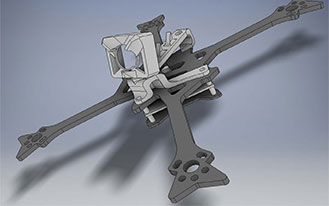
The frame can be designed with replaceable arms, but this means additional hardware, such as screws, bolts and additional base plates. This may mean more extra weight!
You can avoid extra weight through a one-piece design, in which the arm and base plate are single pieces of CF. It is not only lighter but also easier to assemble quads. However, if you break an arm, you will have to replace the entire base plate. Obviously, it is cheaper to replace a single arm, and it is more time-consuming to move all electronic devices and motors to a new chassis. Especially during the game, you often collapse, which means that you are likely to break the framework. Therefore, it is very important for racers to have replaceable spare parts. Modern frame design also brings us a very durable one-piece frame design, but I may only consider the design of free-form four frame, and only consider using CF with a minimum thickness of 4mm (on the 5 "- 6" frame).
Thicker carbon fiber will produce better rigidity and firmness, but it will also become heavier. Durability has the greatest impact on the arms because they bear most of the pressure in the collision. This makes it usually seen that the top, middle and bottom plates are cut from thinner 2mm, or even 1mm CF. 5 "frame usually uses 3mm or 4mm CF, but the progress of racing motor makes 5mm and 6mm more common to withstand higher speed impact with greater force. For 5-inch + frame size, you should look for arms at least 4 mm thick. 3 inch - 4 inch you can drop to 3 mm and 2 inches only 2.5 mm. Anything thinner than this will break too easily.
Treatment of carbon fiber edges
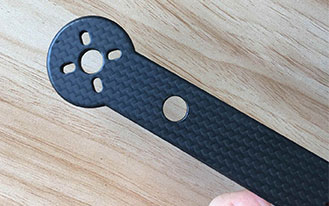
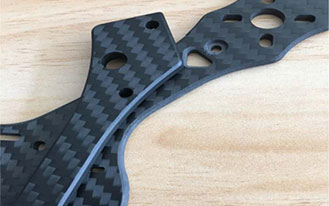
Round edges & Coatting Chamfered edges & Coatting
When receiving the new frame, it is best to handle it carefully, and then wipe it with a wet cloth to remove the residue. If your frame has rough surfaces and sharp edges, we suggest you chamfer the edges not only for better appearance and feeling, but also for the following practical reasons: sharp edges can cut off wires, lipo tape, and other chamfered edges, and then apply cyanoacrylate adhesive (CA) to prevent carbon fibers from layering in hard collisions. In this tutorial, we will show you how to prepare carbon fiber frames by filling edges. It is best to carry out it under running water to avoid inhaling CF dust. Ultrafine particles are harmful to the lungs.
We talked about the shape, structure, material and surface treatment of the drone frame. This is our understanding of the rack as a drone frame processing factory. We believe you real drone users have a better understanding. We would be appreciated if you can send us the best design, and we will implement it for you.
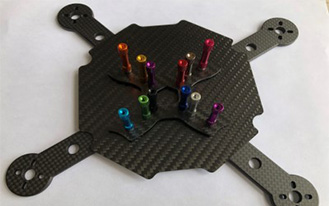
Pulished on Oct. 23, 2023
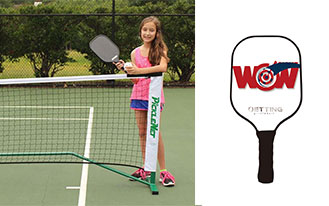
Pulished on Feb. 02, 2023